 Intelligent Design
Intelligent Design
Intelligent Design Is Flourishing in Brazil
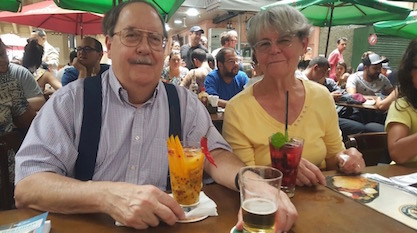
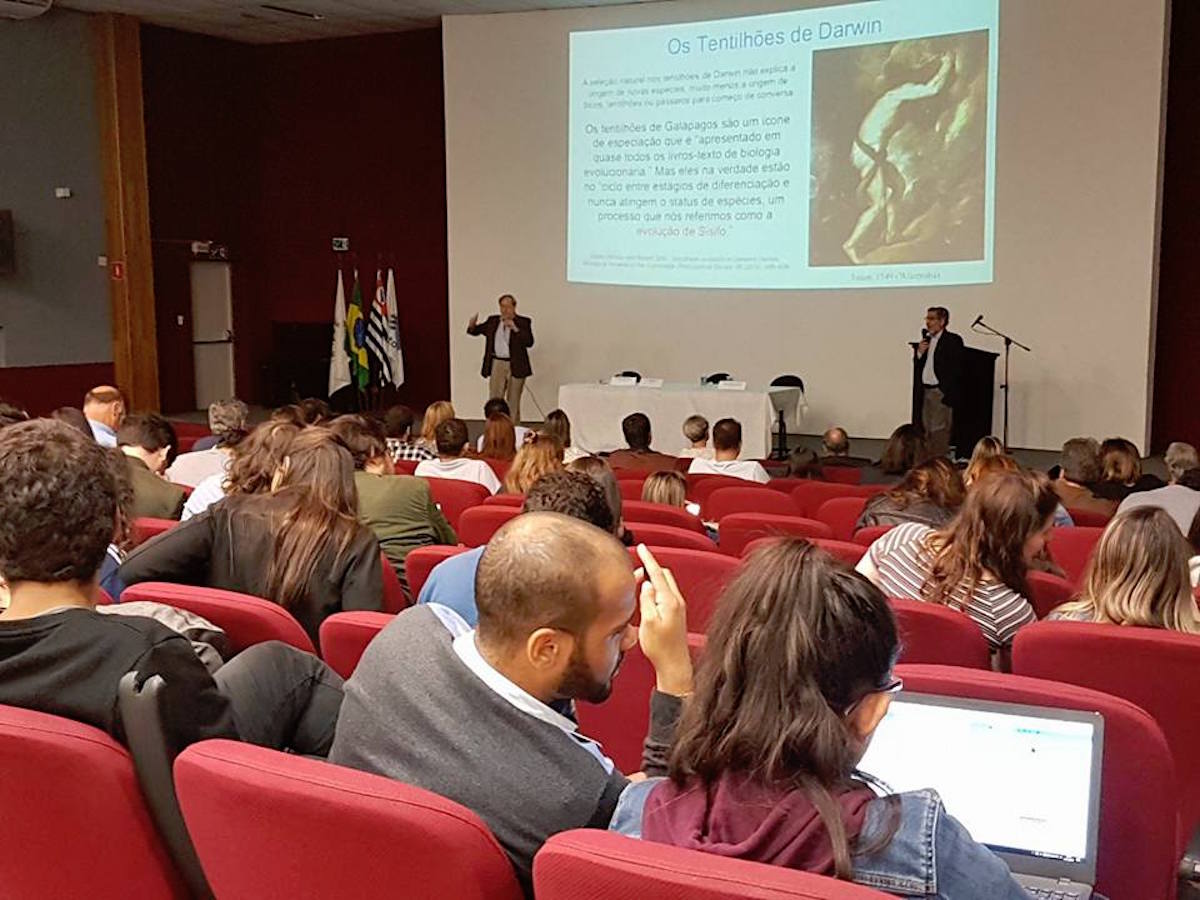
Despite the recent Stalinesque airbrushing of eminent German paleontologist Günter Bechly from Wikipedia for advocating intelligent design, ID’s worldwide influence is growing. My wife Lucy and I just returned from Brazil, the world’s fifth largest and sixth most populous country, where ID is flourishing.
Twenty-five years ago, Brazilian historian of science (and former Marxist-Leninist) Enézio E. de Almeida Filho became skeptical of Darwinism — not because of the Bible, but because of the scientific evidence against it. Enézio (who goes by the nickname Neddy) also read Phillip Johnson’s Darwin on Trial. Neddy started a blog, Desafiando a Nomenklatura Científica (“Defying the Scientific Nomenklatura”), and in 1998 the Brazilian ID movement was born.
ID attracted interest from a number of Brazilian scientists, most notably Marcos N. Eberlin. Marcos is a professor of chemistry at the University of Campinas (UNICAMP), about fifty miles northwest of downtown São Paulo. Marcos’s field is mass spectrometry, a technology used to analyze substances by ionizing and sorting their chemical constituents. UNICAMP is one of the highest-ranking universities in Latin America, and Marcos is a member of the Brazilian Academy of Sciences and 2005 recipient of the Brazilian National Order of Scientific Merit. He is also past president of the International Mass Spectrometry Foundation, which awarded him the prestigious Thomson Medal in 2016.
In November 2014, Neddy and Marcos hosted the inaugural congress of the Sociedade Brasileira do Design Inteligente (Brazilian Society for Intelligent Design) in Campinas, attracting 370 participants from 26 Brazilian states. The principal speaker was Discovery Institute’s Center for Science & Culture (CSC) Senior Fellow Paul Nelson.
In May 2017, the Universidade Presbiteriana Mackenzie (Mackenzie Presbyterian University), one of the oldest institutions of higher education in Brazil, joined with the Seattle-based Discovery Institute to open the Discovery-Mackenzie Research Center in São Paulo. The Discovery-Mackenzie Center “fosters research into the scientific evidence of intelligent design in nature as well as exploring the relationship between science and culture, including the relationship between science and faith.” Discovery Institute President Steve Buri, CSC Research Coordinator Brian Miller, CSC Senior Fellow Mike Behe, and Biologic Institute Director Doug Axe all attended the opening.
Then, following the publication of my book Zombie Science, Discovery-Mackenzie invited me to come to Brazil and give a series of lectures — and they invited my wife Lucy to come as well. Before we went, however, some students at the University of the Algarve in Faro, Portugal organized a conference about intelligent design scheduled for October 23. They invited Marcos and Paul Nelson to come speak, but in September the university cancelled the event. The enterprising students arranged for another venue at the University of Porto, Portugal, and a science dean agreed to speak at the conference. But eight days before the event that university cancelled, too. The students had to drive about six hundred miles across the border to León, Spain, where the conference was finally held at a hotel.
According to Paul Nelson, Marcos was not at all discouraged by the opposition. “Nobody kicks a dead dog,” he said. Obviously, ID is alive and well, or the people who tried to shut it down would not have bothered.
Arrival in São Paulo
In the evening of November 2, 2017, Lucy and I arrived in São Paulo (a city of 12 million) and settled in to a hotel a few blocks from the main campus of Mackenzie Presbyterian University. At 11:00 AM on Saturday, November 4, Marcos with his wife Elizabeth and her mother and their two children picked us up at the hotel and drove us through downtown São Paulo to the Mercado Municipal (City Market). The market was extremely crowded — almost shoulder-to-shoulder. Marcos’s daughter Nina was hungry, and we went upstairs for lunch. Lucy and I had had a late breakfast, so we weren’t hungry, but Marcos treated us to two different flavors of caipirinha (kye-pa-REEN-ya), the Brazilian national cocktail made with sugar cane liquor and lime or various fruits.
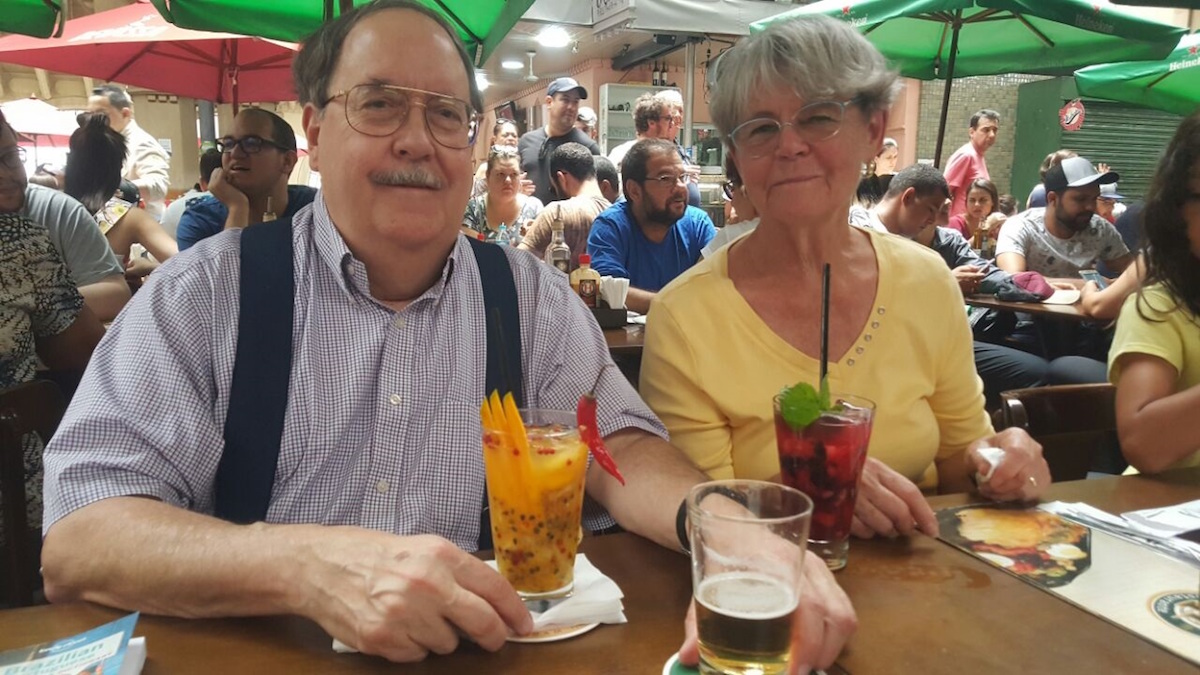
Sampling caipirinhas at the Mercado Municipal in São Paulo.
The Mercado Municipal consists mainly of an amazing array of food concessions. We stopped at one that had fresh fruits from all over the world, and the salesmen cut free samples for us from a dozen of them. (Marcos ended up buying several bags full.) Then we got some ice cream for his children.
The following morning (Sunday), Lucy slept in to recover from jet lag. I was picked up early from the hotel by a young Brazilian man (Guilherme, the Brazilian equivalent of Guillermo or William) who had spent a year and a half studying in North Carolina and had become quite proficient in English. Guilherme drove me to a small Presbyterian church several miles away where his father is the pastor and Guilherme is the pianist.
After the opening hymn (“How Great Thou Art,” one of my favorites), Bible reading, announcements and sermon, I went up to the front with Guilherme. I began by saying “Bom dia. Eu não falo Português. Desculpa” (pronounced Bong JEE-a. Ay-OO now FAH-lo Por-tu-GUESS. Des-COOL-pa), or “Good day. I do not speak Portuguese. Sorry.” I had worked on my opening during the all-Portuguese sermon with help from my pocket English-Portuguese dictionary, but I still stumbled over “falo.”
Guilherme then introduced me, and I spoke for a while about the distinction between empirical science, naturalistic “science,” and “zombie science,” emphasizing that religion had nothing to fear from empirical science. Guilherme translated after each sentence. When I finished Guilherme whispered in my ear that the congregation (about 50 men, women, and children) wanted to hear more, so I continued speaking in more detail about intelligent design. Then we opened the floor for a Q&A.
Guilherme had forewarned me that the congregation would probably be too shy to speak, but they immediately began asking questions and the Q&A lasted for more than half an hour.
The best questions came from a teacher who was accompanied by his teenaged daughter and son. He pointed out that public schools emphasize Darwinism but mention creationism only to dismiss it. Then I said I do not recommend requiring the teaching of creationism or ID in public schools. Guilherme looked at me with surprise, but I explained that the best strategy is to teach students MORE about Darwinism, especially the evidence against it.
Afterwards, many members of congregation came up to greet me and practice their English. They invited me to their weekly church luncheon, but when Guilherme realized how tired I was he drove me back to the hotel instead.
Visiting Mackenzie University
At 1 PM the next day (Monday, November 6), Marcos and Neddy picked us up at the hotel. Neddy and I had never met before, though we have been corresponding by email for more than 20 years. Marcos and Neddy drove us to the main campus of Mackenzie University, a few blocks away, where Lucy and I were given a tour and welcomed by various VIPs, including the university’s rector, Dr. Benedito Guimarães Aguiar Neto.
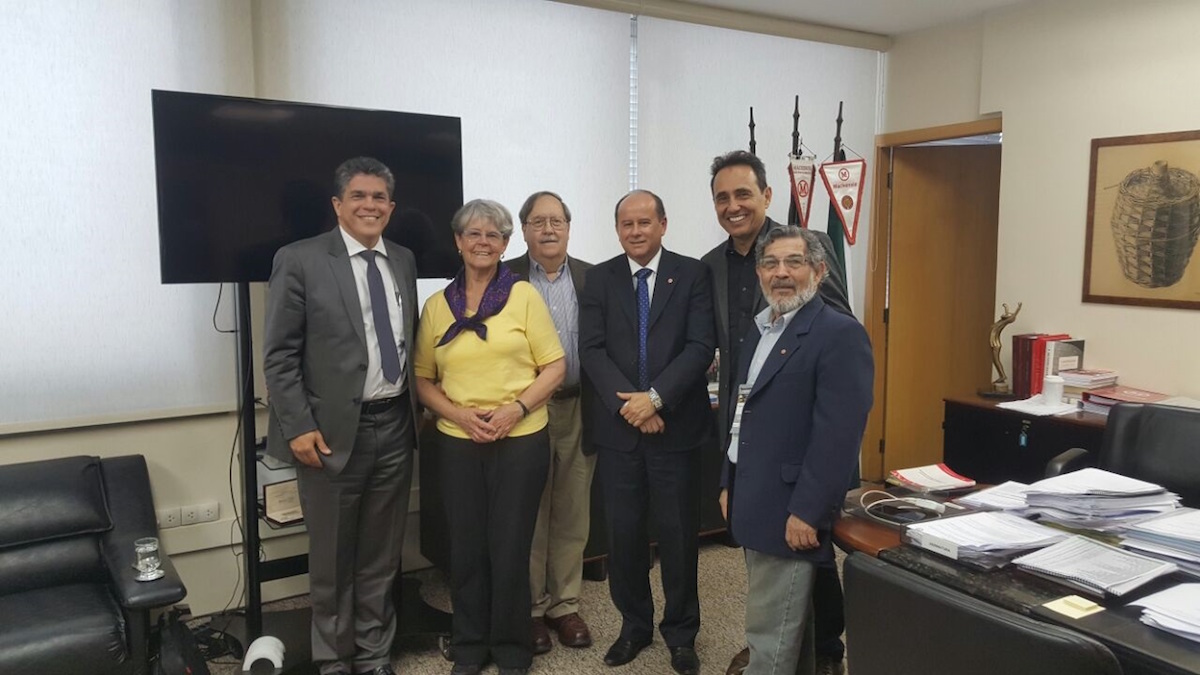
In the office of Mackenzie-São Paulo rector Dr. Benedito Neto, between Jon and Marcos.
While we were at the administration building, Marcos and Neddy signed a contract to translate Zombie Science into Brazilian Portuguese — a fact we mentioned in all my subsequent talks. (Brazilian Portuguese is roughly as different from the language spoken in Portugal as American English is different from the language spoken in England.)

Dr. Marcos Eberlin signs the contract to translate Zombie Science into Portuguese. Standing, left to right: Neddy, Lucy, Jon.
At 4 PM I gave the first of four lectures titled “Zombie Science: How Discredited Icons of Evolution Are Used to Promote Darwinism.” (I would subsequently give the same lecture on three more campuses.) Before coming to Brazil I had emailed this presentation and two others to Neddy, and he had translated all my slides into Brazilian Portuguese. So he did most of the talking by reading what was on my slides, while I inserted a few spontaneous remarks from time to time that Neddy translated on the fly.

Lecturing at Mackenzie-São Paulo, with Neddy translating.

This was the opening slide for four university presentations. Neddy could have translated “zombie” as “zumbi,” but he felt that “mortos-vivos” (“walking dead”) was more attention-getting.
There were at least 60 people in the audience. The Q&A was lively, well informed and respectful. It could have continued quite a while longer, but we had to hurry across town for my second talk at a large Adventist university, Centro Universitário Adventista de São Paulo (UNASP).
It was a wild ride through the streets of São Paulo. The streets are narrow, winding, and very bumpy, and people drive very fast. There are almost as many motorcycles as there are cars, and the cyclists drive faster than the cars and weave in and out of traffic like circus daredevils. But Marcos is a veteran São Paulo driver, and he delivered us safely. At one point I told him that as a former New York City taxicab driver I admired his skill.
During the ride, Lucy and I (in the back seat) got to know our hosts better. Neddy may come from a Jewish background (he’s still checking genealogical records) and he always wears a yarmulke, but he describes himself as an orthodox Calvinist. Mackenzie is a Presbyterian university with pictures of John Calvin everywhere you turn, but Marcos is a Baptist. Go figure. Neddy and Marcos are best friends, but they argue constantly in a good-natured sort of way. Each one blames the other for all their mistakes (“It’s all your fault!”) In the car, they also argued over free will and predestination.
On the way, Marcos and Neddy serenaded us with the Brazilian song “Maluco Beleza,” or “Cool Crazy Man.” They said this is the official theme song of the Brazilian ID movement, because only “malucos belezas” are sufficiently independent-minded to stand up for ID in the face of materialistic orthodoxy. The song had been made famous by the late Brazilian singing star Raul Seixas, and according to Marcos and Neddy he sang it better than they. “I hope so,” I said, and they laughed.
The lecture hall at UNASP was packed, with people standing in the back. There were at least 160 people in the audience. As I had done at the church the day before, I began with “Eu não falo Português. Desculpa.” Neddy translated this into English, and everybody laughed. Then, since Neddy and I had just delivered the same presentation at Mackenzie, things went very smoothly.
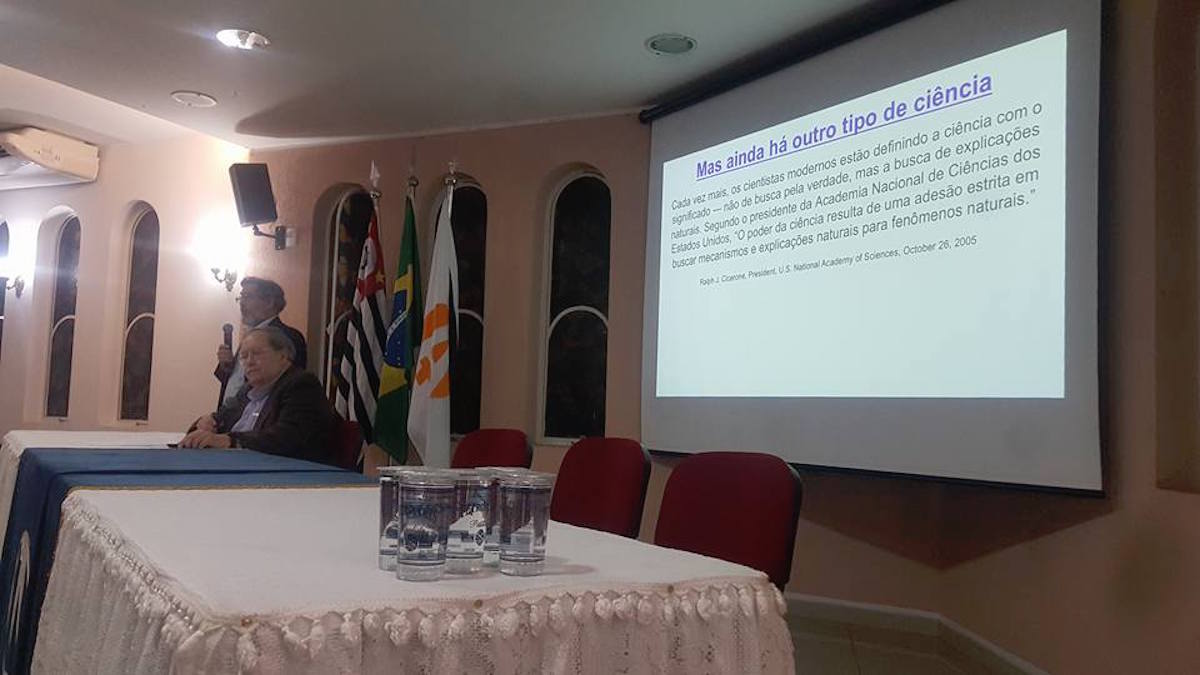
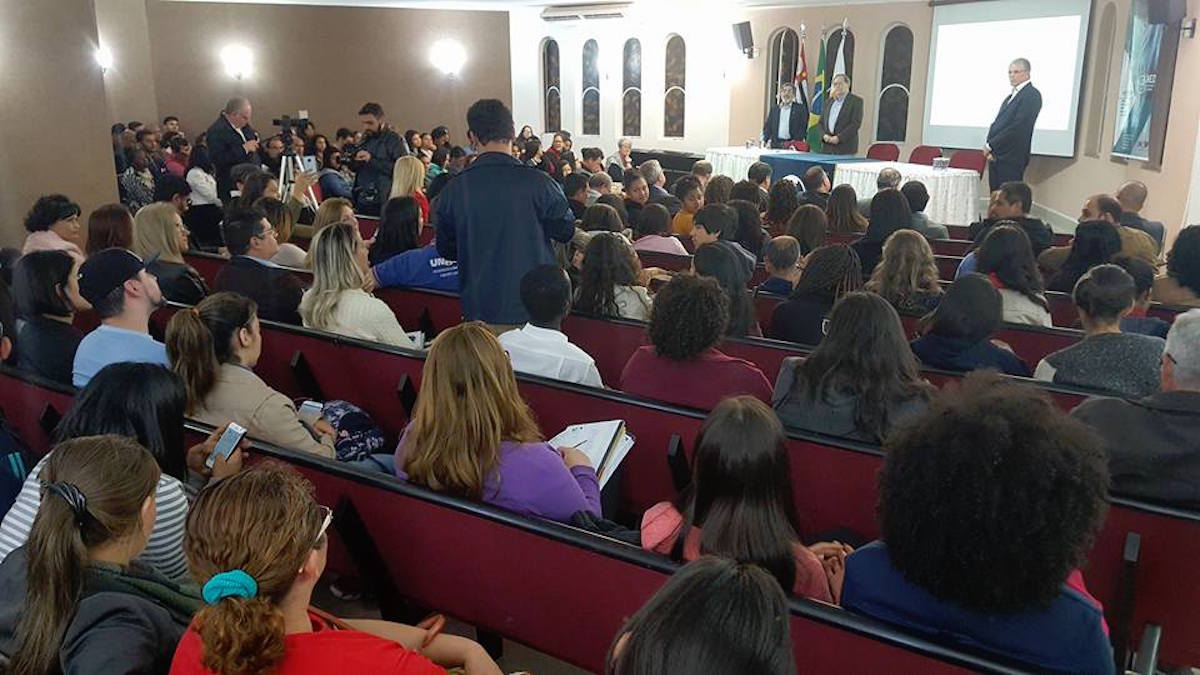
Lecturing and Q&A at UNASP.
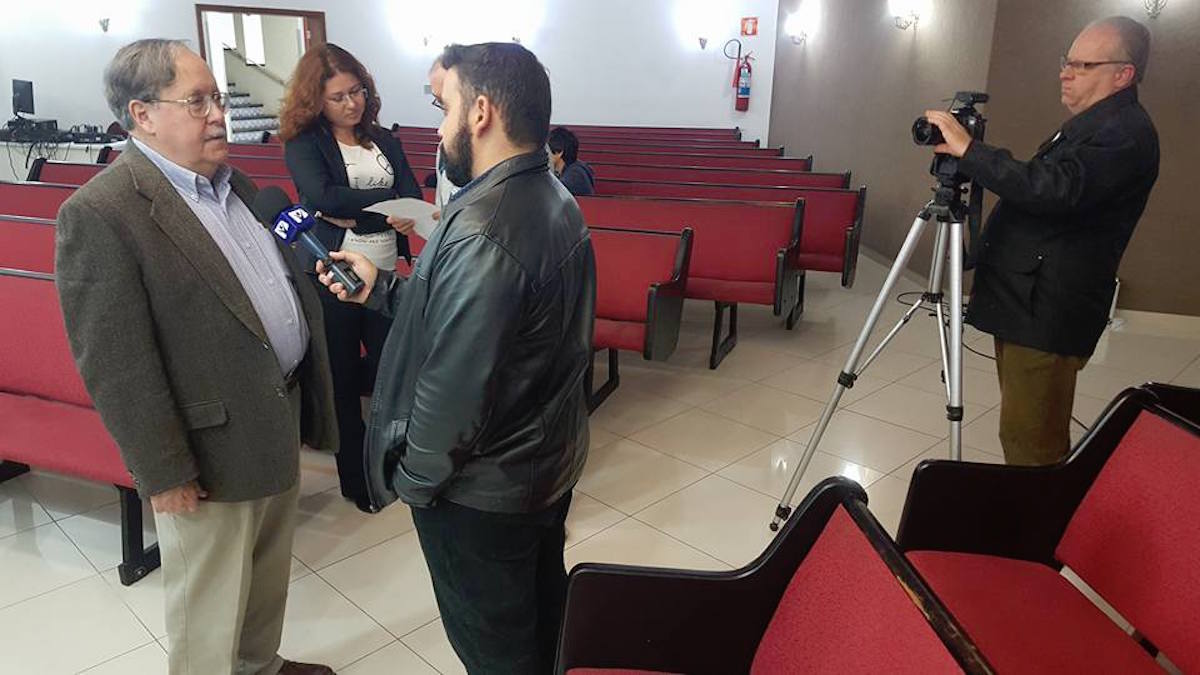
Interviewed by journalists at UNASP.
The Q&A — like the Q&A at Mackenzie — was lively, well informed, and respectful. At one point Enézio started to answer a questioner in English, and the audience shouted “Português!” I reached for the microphone as though I was going to translate for him, and everybody laughed again. The whole event was great fun.
Visiting Campinas
On Tuesday a driver picked up Lucy and me and took us to Campinas, where Marcos lives. Campinas, with over a million people, is a beautiful city. Marcos took us all out to lunch at an upscale restaurant that served Brazilian sandwiches and Brazilian beer, then we stopped by his house to pick up Elizabeth. From there we went to the Campinas campus of Mackenzie, where I was scheduled to lecture that evening. As on the previous day, with Neddy’s help I finished my presentation early, leaving lots of time for my favorite part — the Q&A. There were about 180 people in the very friendly audience, including lots of students.

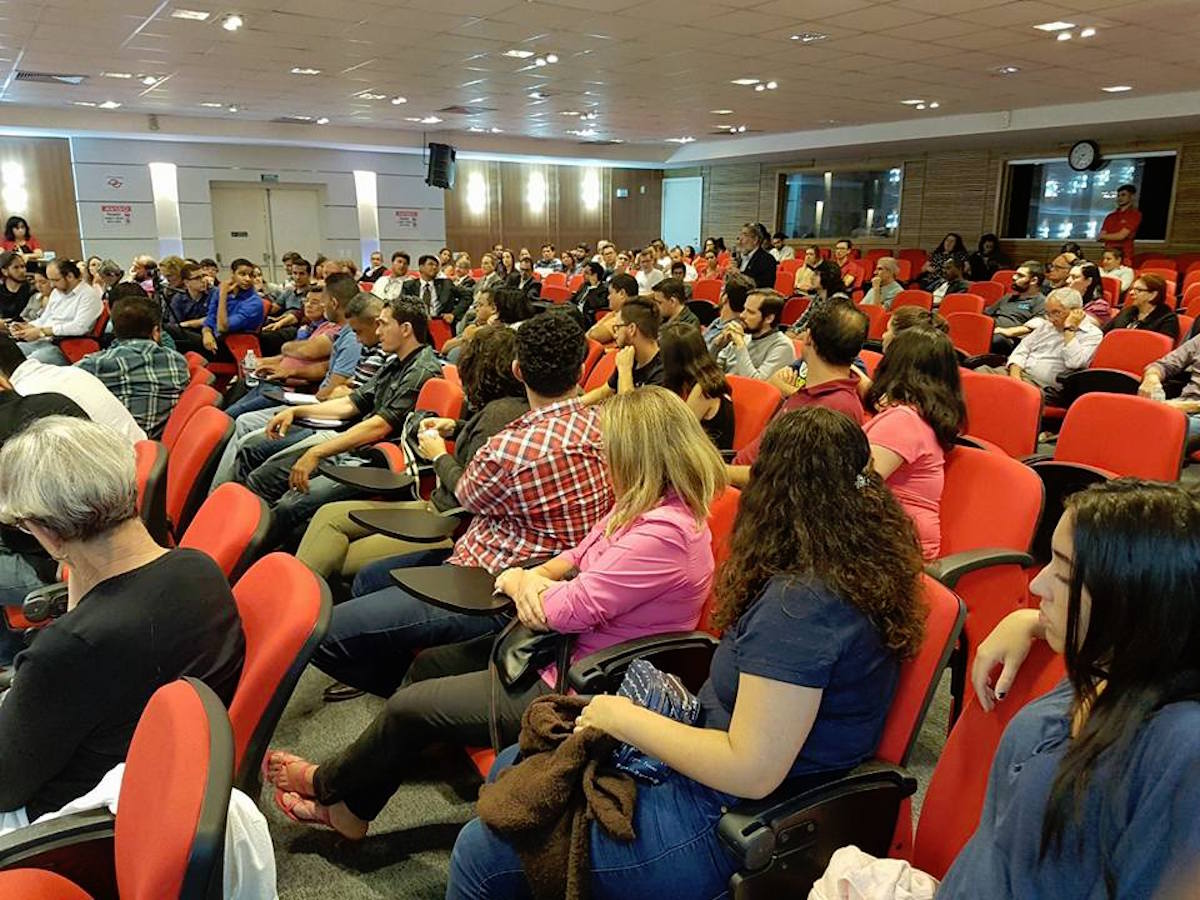
Lecturing and Q&A at Mackenzie-Campinas.
There were some good questions about mutations, but I thought the most interesting question came from a Mackenzie professor of environmental science who had become very animated during my talk. She asked me whether ID could provide any help in dealing with environmental problems. I said there was evidence that the environment (at least in a general sense) was designed, and I mentioned Michael Denton’s recent books on the subject. Since the environment is designed, I said, we should do our best not to screw it up, and she agreed enthusiastically. But since I’m not an ecologist I did not know of more specific ways in which ID might guide us.
The next day (Wednesday, November 8) I gave my fourth and final Zombie Science lecture at a Methodist university (Universidade Metodista de São Paulo). Since this was the most theologically liberal of the four universities we visited, we expected the audience might be more critical than the others. But they were just as friendly as the others. There were about 200 in attendance, and afterwards the rector of the university and director of the School of Communication, Education, and Humanities honored me with a “Certificado” for my lecture.
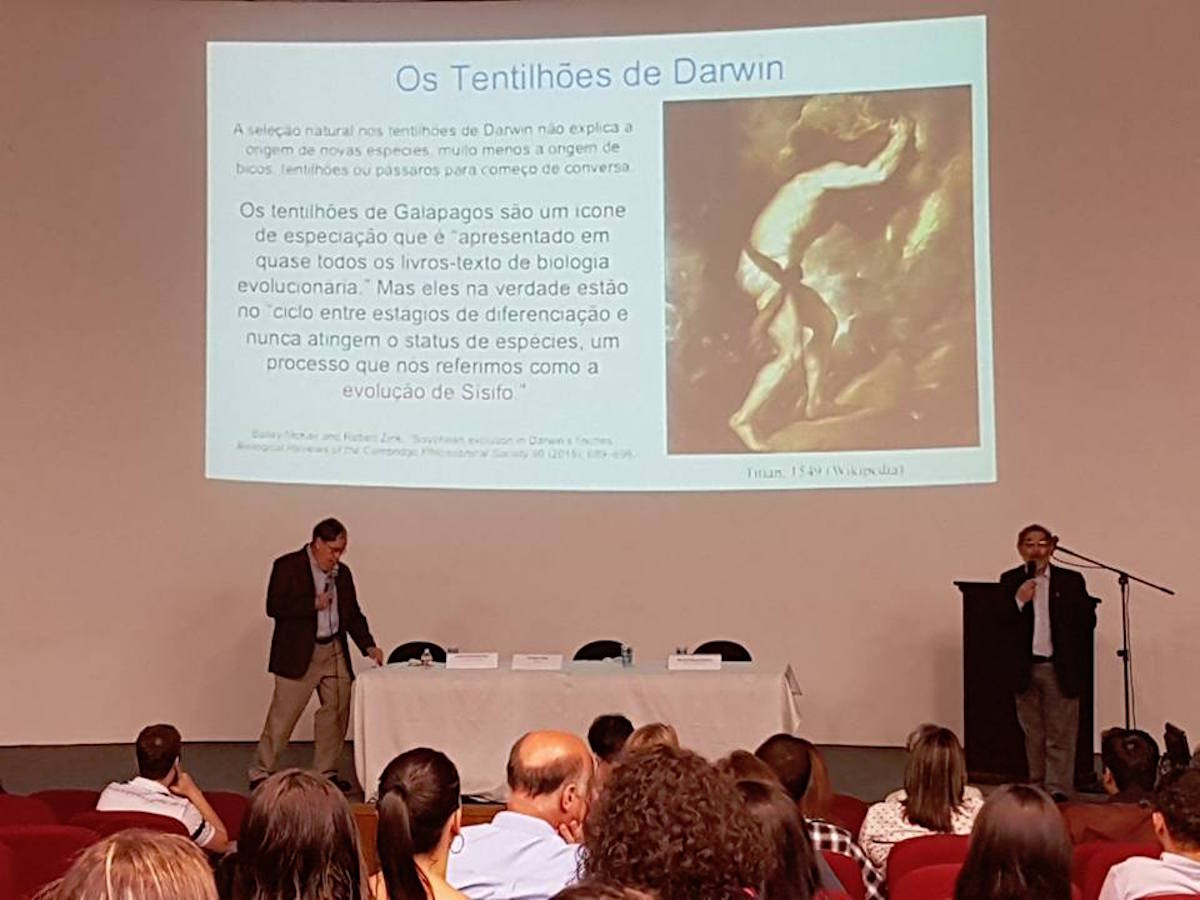
Lecturing at Universidade Metodista de São Paulo.
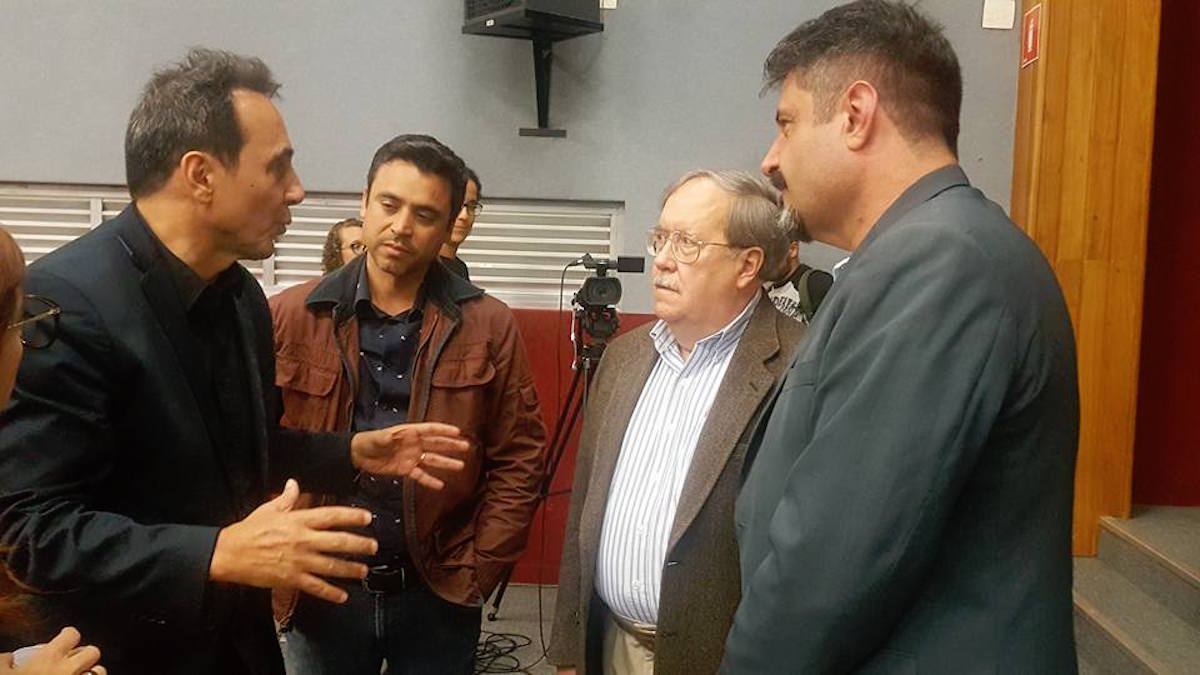
Talking with Marcos and audience members.
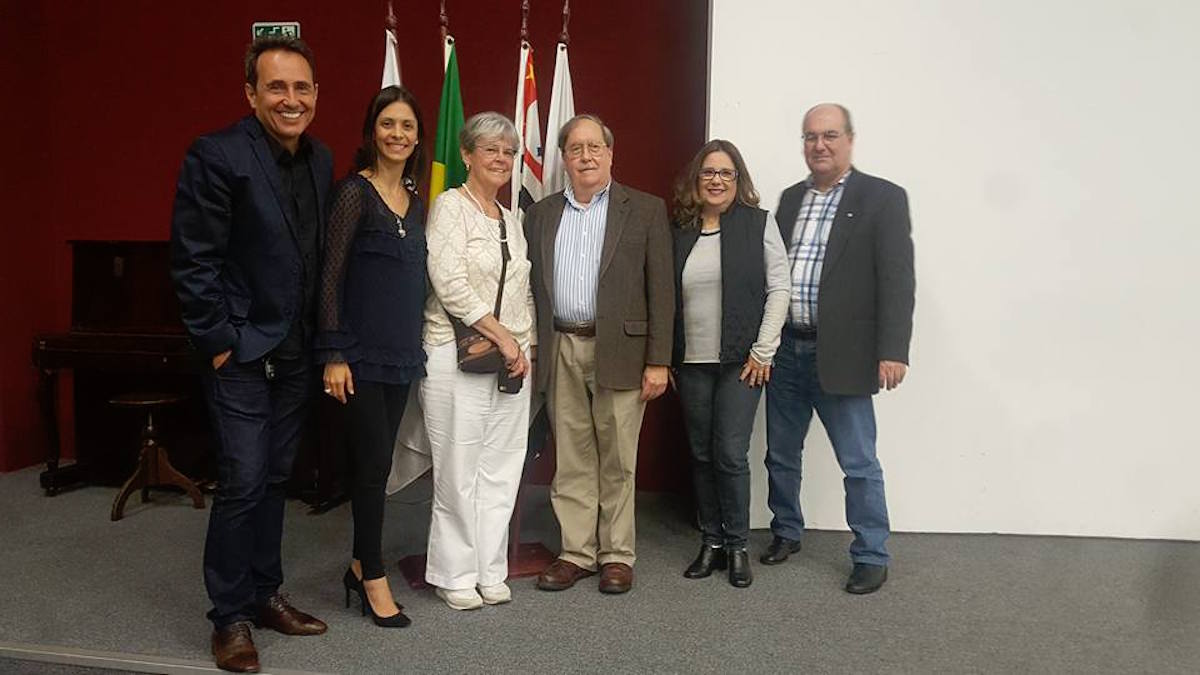
After the lecture at Universidade Metodista de São Paulo. Left to right: Marcos, Elizabeth, Lucy, Jon, Professor Carrilho’s wife, and Professor Kleber Carrilho (Director of the School of Communication, Education, and Humanities).
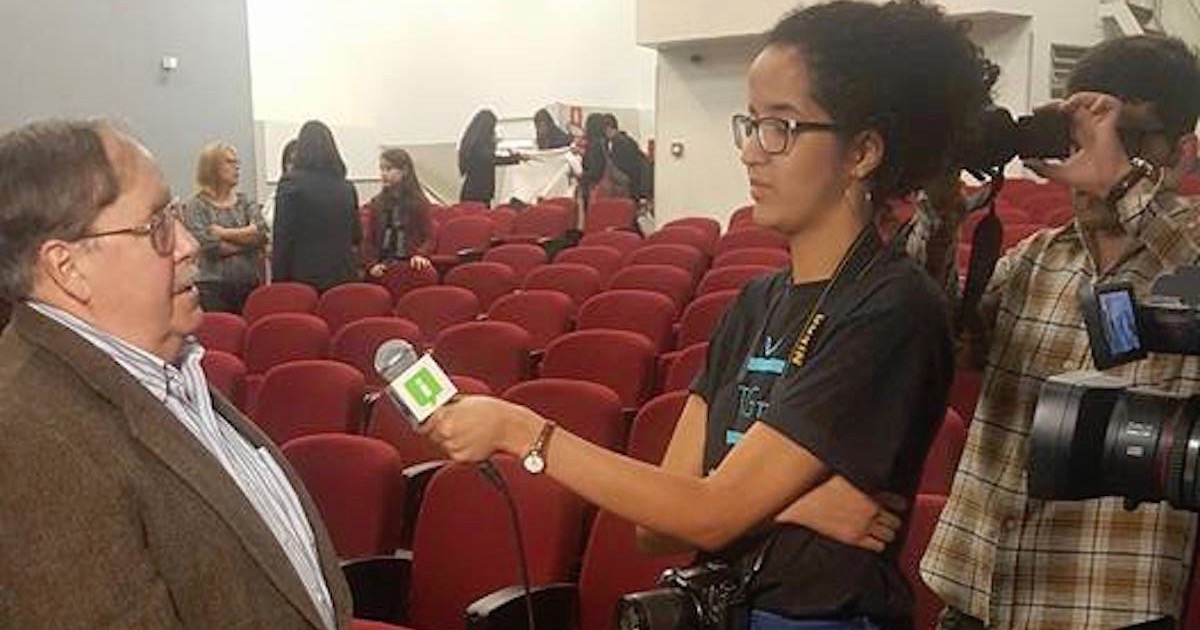
Interviewed by journalists.
Then Marcos, Elizabeth, and Neddy took us out for churrasco (pronounced chew-HOSS-koe), a traditional Brazilian feast in which servers dressed like gauchos (Brazilian cowboys) come around to the table every few minutes and offer you slices of freshly roasted beef, chicken, or pork impaled on swords. The best and most prized cut is a top sirloin called picanha, pronounced pick-ONN-ya.
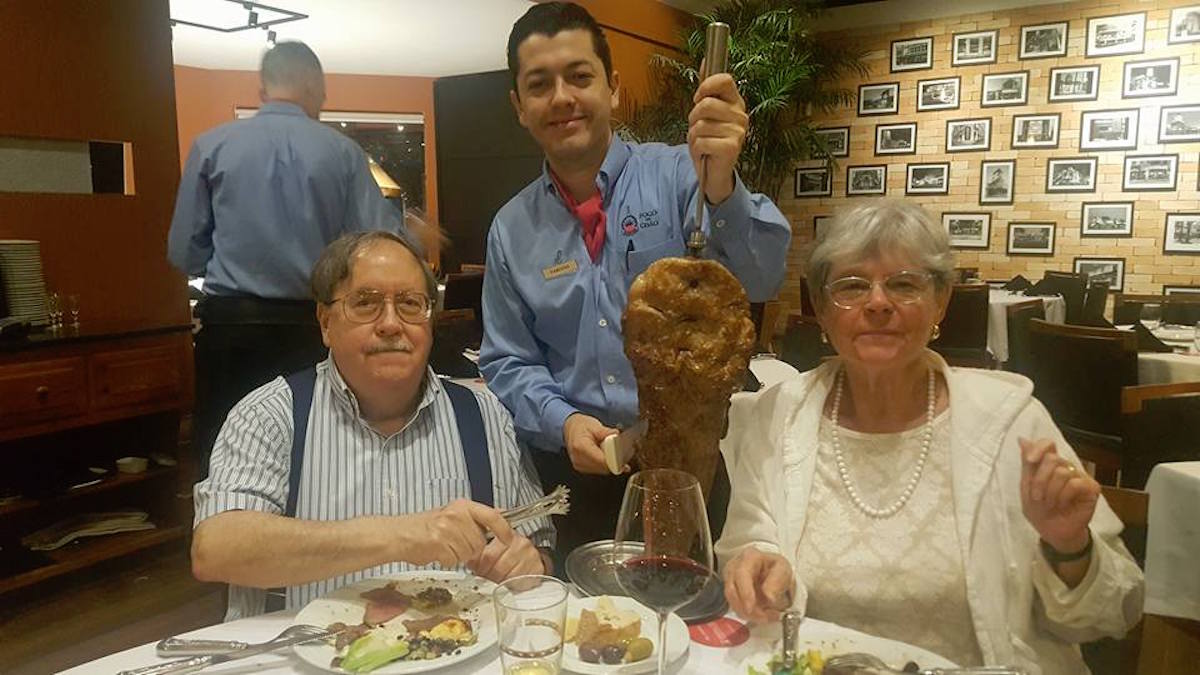
With Lucy at a churrascaría (churrasco restaurant) in São Paulo.
On to Fortaleza
The next morning (Thursday, November 9), Lucy and I departed for Fortaleza, on the northeast coast of Brazil, where I was scheduled to give two talks at a meeting of the Brazilian ID society. Fortaleza is a beautiful coastal town, almost on the equator, and our hotel room overlooked a magnificent beach. We were told Fortaleza would be very hot, but there was a steady breeze coming off the Atlantic Ocean, so it was really quite comfortable. The evening of our arrival our local host Fabiano and his wife took us out for a delicious Brazilian shrimp dinner and a walk around the neighborhood.
On Friday, November 10, the Simpósio de Design Inteligente do Nordeste (Northeast Symposium on Intelligent Design) started at 7 PM, in an auditorium at the School of Law of the Universidade Federal de Ceará (UFC), or Federal University of Ceará. (Ceará is the state in which Fortaleza is situated.) Neddy and Marcos were proud not only of the fact that the Symposium was hosted by the law school of a public university, but also of the fact that “UFC” can refer to “Ultimate Fighting Championship,” a rough-and-tumble form of mixed martial arts fighting.
I had the honor of speaking first, on the question “Is Intelligent Design Science or Religion?” I explained the difference between empirical science (the search for truth by testing hypotheses against evidence), consensus science (the current majority opinion of professional scientists), and naturalistic science (the search for materialistic explanations for everything). I also distinguished between religion as belief in God, religion as a particular form of worship (e.g., Catholicism), and religion as an ultimate commitment to some idea or activity (e.g., the Marxist view of history or the pursuit of money and power). I concluded that because inferences to design are tested against the evidence, ID is empirical science. But I quoted Harvard evolutionary biologist Richard Lewontin’s famous admission that he and his colleagues have “a prior commitment to materialism,” and “that materialism is absolute, for we cannot allow a Divine Foot in the door,” and I concluded that naturalistic science is religion in the third sense of the word.
Marcos spoke next, on “The Three Pillars of Intelligent Design.” Although his talk was in Portuguese, my familiarity with the subject enabled me to follow his general argument. The first pillar is irreducible complexity. The second is information, which requires a mind. Marcos used the examples of Morse code, barcodes, and ASCII code, and he concluded by analogy that the genetic code also originated in a mind. The third pillar is the ability to foresee where a process is headed. He illustrated this with a cartoon of a mouse facing a baited mousetrap: The mouse was wearing a football helmet. The audience had a hearty laugh.
The third talk (also in Portuguese) was by Dr. Glauco Barreira Magalhães Filho, a professor at the UFC Law School, on “Who is the Designer according to good philosophy and theology?” One of his main points, I gathered, was that ID does not tell us who the Designer is: That takes additional philosophical and/or theological arguments.
The evening concluded with a Q&A involving all three of us. As it turned out, I got the last word. Someone asked how ID could succeed against the overwhelming dominance of naturalistic science, and Marcos indicated he wanted me to respond (with Neddy translating). So I took a cue from the last chapter of Zombie Science. I explained that as a boy I used to ice skate in the wintertime on a nearby frozen pond, but as spring approached the ice would become honeycombed with meltwater. It still looked thick and strong, but my friends and I knew it could no longer hold our weight. I concluded that naturalistic science is like spring ice: It is not as strong as it looks, and soon it will melt. The audience cheered.
Lectures, and Many Photos
The following day (Saturday, November 11), the lectures (all in Portuguese) were by molecular biologist Mariana Sá (on design in DNA), chemist Rodolfo Paiva (on inferences to the best explanation), neurobiologist Ricardo Marques (on the persecution of scientists such as Guillermo Gonzalez and Richard Sternberg), and Otângelo Grasso (on design in molecular machines). The conference organizers then took us and the other speakers out for a churrasco lunch.

On the beach at Fortaleza; left to right, Marcos, Otângelo Grasso, Neddy, and Rodolfo Paiva.
After lunch, Brazilian physicist Douglas Aleodim spoke on “Twenty years of irreducible complexity: proven or refuted?” Among other things he rebutted Ken Miller’s criticisms of Mike Behe’s argument for irreducible complexity. Dr. Tassos Lycurgo then gave a hilarious talk on “Science and its presuppositions.” Since it was in Portuguese I didn’t understand a word of it, but every few minutes the audience howled with laughter. Marcos Eberlin then gave a talk titled “Who came first: the egg or the chicken?” His main point, I gathered, was the need for information.
I spoke last on a “Brief History of ID.” I showed lots of photos and talked about Pajaro Dunes, Mere Creation, the founding of Discovery Institute and the CSC, some of our many books and videos, Ohio and Kansas, and the Dover Trial. I finished with a short summary of some current ID research projects.
The Symposium was attended by close to 400 people. Afterwards, it seemed that everyone in the audience wanted to have his or her picture taken with me. Over the years I’ve been to many conferences in North America, Europe, Africa, and Asia. But not even in Japan, where people are famous for taking lots of photos, have I posed for more photos than after this one. I told Neddy and Marcos that the Symposium set a record on that score, and Marcos explained that he had encouraged everyone to take photos and post them on the Internet — Facebook, blogs, websites, whatever. He wants ID to spread so quickly in Brazil that it will be too big for its opponents to shut it down when they finally get their act together. I’d say he’s well on his way to succeeding.
